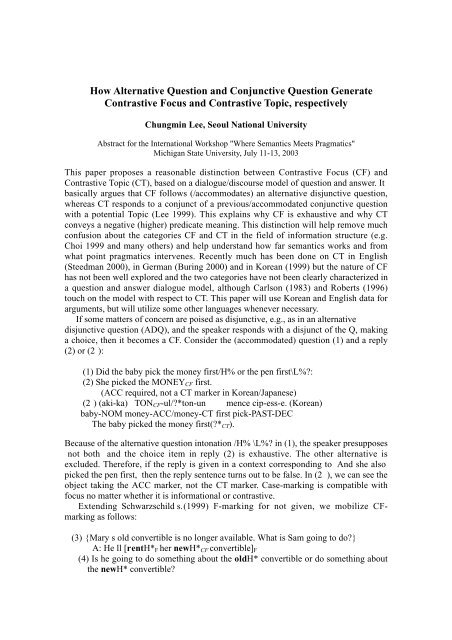SemPrag03.Progr.pdf - Institut für Linguistik/Germanistik - Universität ...
SemPrag03.Progr.pdf - Institut für Linguistik/Germanistik - Universität ...
SemPrag03.Progr.pdf - Institut für Linguistik/Germanistik - Universität ...
You also want an ePaper? Increase the reach of your titles
YUMPU automatically turns print PDFs into web optimized ePapers that Google loves.
How Alternative Question and Conjunctive Question Generate<br />
Contrastive Focus and Contrastive Topic, respectively<br />
Chungmin Lee, Seoul National University<br />
Abstract for the International Workshop "Where Semantics Meets Pragmatics"<br />
Michigan State University, July 11-13, 2003<br />
This paper proposes a reasonable distinction between Contrastive Focus (CF) and<br />
Contrastive Topic (CT), based on a dialogue/discourse model of question and answer. It<br />
basically argues that CF follows (/accommodates) an alternative disjunctive question,<br />
whereas CT responds to a conjunct of a previous/accommodated conjunctive question<br />
with a potential Topic (Lee 1999). This explains why CF is exhaustive and why CT<br />
conveys a negative (higher) predicate meaning. This distinction will help remove much<br />
confusion about the categories CF and CT in the field of information structure (e.g.<br />
Choi 1999 and many others) and help understand how far semantics works and from<br />
what point pragmatics intervenes. Recently much has been done on CT in English<br />
(Steedman 2000), in German (Buring 2000) and in Korean (1999) but the nature of CF<br />
has not been well explored and the two categories have not been clearly characterized in<br />
a question and answer dialogue model, although Carlson (1983) and Roberts (1996)<br />
touch on the model with respect to CT. This paper will use Korean and English data for<br />
arguments, but will utilize some other languages whenever necessary.<br />
If some matters of concern are poised as disjunctive, e.g., as in an alternative<br />
disjunctive question (ADQ), and the speaker responds with a disjunct of the Q, making<br />
a choice, then it becomes a CF. Consider the (accommodated) question (1) and a reply<br />
(2) or (2 ):<br />
(1) Did the baby pick the money first/H% or the pen first\L%?:<br />
(2) She picked the MONEY CF first.<br />
(ACC required, not a CT marker in Korean/Japanese)<br />
(2 ) (aki-ka) TON CF -ul/?*ton-un mence cip-ess-e. (Korean)<br />
baby-NOM money-ACC/money-CT first pick-PAST-DEC<br />
The baby picked the money first(?* CT ).<br />
Because of the alternative question intonation /H% \L%? in (1), the speaker presupposes<br />
not both and the choice item in reply (2) is exhaustive. The other alternative is<br />
excluded. Therefore, if the reply is given in a context corresponding to And she also<br />
picked the pen first, then the reply sentence turns out to be false. In (2 ), we can see the<br />
object taking the ACC marker, not the CT marker. Case-marking is compatible with<br />
focus no matter whether it is informational or contrastive.<br />
Extending Schwarzschild s.(1999) F-marking for not given, we mobilize CFmarking<br />
as follows:<br />
(3) {Mary s old convertible is no longer available. What is Sam going to do?}<br />
A: He ll [rentH* F her newH* CF convertible] F<br />
(4) Is he going to do something about the oldH* convertible or do something about<br />
the newH* convertible?

















